Download Full Presentation Here
I’d like to start with a metaphor. I like to think of content like an iceberg. The tip of the iceberg is really that’s the final product. That’s the content that people consume. When we think about content, this is often what people are thinking about.
However, there’s a whole lot of work that goes into developing good content and that’s content strategy. That’s all the work that goes into making sure that the right people see the right content at the right time. The bulk of the content work is invisible to create good content.
So to start off with just some scenarios if these sound familiar:
- Have we ever had late content delay the launch of a website?
- Have we ever created page templates that look great, but ultimately don’t work when the real content goes in?
- Have you ever visited a site we redesigned a few years later and been like, “what the heck happened here?”
- Have we ever used lorem ipsum and designs because we don’t have real content to work with?
- Have you ever had a bunch of opinions on content requirements come out of the woodwork at the 11th hour?
I don’t know about you all, but I have certainly encountered every one of these scenarios.
So taking a content first approach to projects can really help to avoid a lot of these issues. I do want to be clear here that this doesn’t mean that all of the copy needs to be written for a website before we can design it. What it means is that at every step of the design process from discovery through launch we need to be thinking about content.
Starting with some just basic definitions.
What is content? I like to think of content pretty simply and broadly as just being helpful information. Content can take a whole lot of forms: web pages, blog posts, videos, presentations, webinars, PDFs print handouts, and so much more.
Content strategy is planning for the creation and publication and governance of useful usable content. This is the industry accepted definition for content strategy at this point. It’s still an emerging field, so there’s new research coming out about this all the time and new ideas. It’s a pretty exciting field to be getting into, and I think it’s a good differentiator for us.
“Content strategy plans for the creation, publication, and governance of useful, usable content.”
Kristina Halvorson, CEO and founder of Brain Traffic, author of Content Strategy for the Web
Content strategy is made up of these five kind of essential components. Core strategy, which sits at the center of everything. And then there’s content components and people components. The content components are substance and structure. The people components are workflow and governance. I will say that people often forget about the people components and that is just so critical to figure out because otherwise your strategy is just going to fall flat on its face, and it’s not going to go anywhere if there’s no one championing it and there’s no one owning.
To go into a little more detail on these things:
- Core strategy is your strategy touchstone. This is the thing that you’re always going to come back to in terms of the long-term direction that you’re trying to achieve. It really defines how the organization is going to use content to achieve its objectives as well as meet user needs.
- Content components substance is figuring out what content you need and why this is thinking about what topics you’re going to write about. What format should your content be in? Are videos, audio files, or words better received by your audience? Sources of content: Are you going to be creating this content? Are you going to be curating content from other sources? Substance also is about what messages content needs to communicate to your audience, which is getting at message architecture, and I’ll go into a little more detail on that later.
- Structure is thinking about how your contents needs to be prioritized, organized, formatted, and displayed. This is the information architecture site maps, metadata wireframes, linking strategies, stuff like that, about how content is stored.
- Moving over to the people components side of the circle, workflow is figuring out what processes, tools and human resources are going to be needed for content to launch successfully and be maintained and maintain that quality.
- Governance is how key decisions about content and content strategy are made and how those changes are initiated and communicated. So it’s a lot about ownership and policy.
At the end of the day content strategy is really all about communication. Put your content strategy hat on, you’re trying to answer these fundamental questions:
- Who do we talk to (target audience)?
- What do we talk about (topics & messaging)?
- How do we talk about it (voice and tone)?
- Where do we talk about it (distribution channels)?
- Why are we talking about this (what is our goal)?
Hopefully you see some overlap here between what we’re already doing, especially in terms of user experience and our branding offering. Their content strategy sits in the middle of those two things.
So how do you do content strategy?
It often starts with a content audit. A content audit is really a reality check. It’s an honest look at what you have and where you’re at today. There are different types of audits and you’ll choose different types of audits depending on the current stage of the project, what you’re looking at, what the pain point is that you’re trying to solve, etc.
Quantitative audits are really numbers-based. You’re looking at amounts, what do you have, and how much. It’s very specific and it’s very measurable.
Qualitative audits are where it gets a little more in-depth and it’s evaluating is what you have in a good, so it’s taking it to the next level and really looking at quality.
And then a more advanced qualitative audit starts to take into account competitor content and figuring out what content you don’t have. Making plans for where future content could better meet your users.
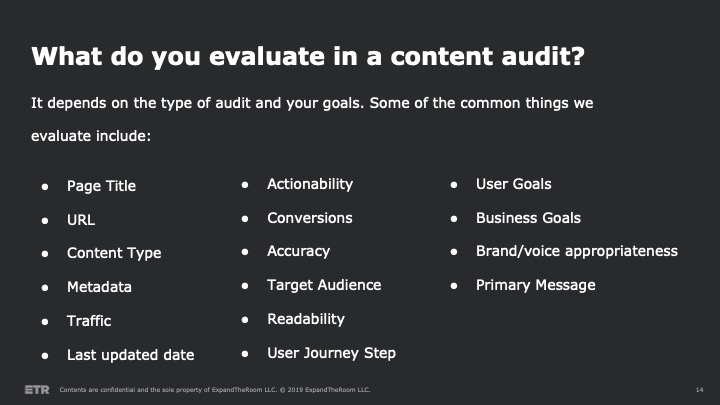
Some things that you evaluate as part of a content audit include all of the things you see here. It really depends on the type of audit that you’re conducting and the goals in terms of what data you’re going to want to collect. It’s easier to start with the qualitative audit, the how much and the what you have, and progressively get more advanced as you go.
Doing an audit really is spreadsheet hell, I’m not gonna lie. It’s really tedious and time-consuming, but I promise it is worth doing every time. You will always learn something. And as we all believe in as part of Purpose-Driven Design, you can’t guess your way to credibility. Unless you understand what you’re currently working with, you’re not going to have a great foundation on which to make future recommendations.
Once you’ve gathered all of your data in a spreadsheet or multiple spreadsheets it’s time to really crunch numbers, do some math, set up some formulas, calculate some stuff, mix and match based on different criteria, look at your content through a bunch of different lenses and a bunch of different ways and try to find interesting patterns. Something always jumps out and sometimes it’s surprising, sometimes it’s expected. Either way, it helps to either validate hypotheses that you already have, or you learn new things that you just didn’t even know existed.
Specifics in terms of analysis is going to vary depending on what your audit doing, because the goals are going to be different. It really depends on what your client is trying to achieve and trying to understand about their content. This step is so important as the foundation for content strategy work, because it gives you all the hard numbers and rationale to back every one of your strategic recommendations. So similar to how we use a creative direction coming out of a a discovery effort to set the tone for how we’re going to design the site and what principles we’re going to be looking at. That’s what this data helps us do for content strategy.
Once you have all the analysis done, you synthesize those findings into a digestible format. I typically go with a deck putting together visual graphics because people only have so much tolerance for looking at a data-heavy spreadsheet. You gotta make it a little visual. Then use all those synthesized findings to create a strategy.
This is really the fun part and where you get to be a little visionary and get out of where you currently are and really picture the future. Strategy is an aligned vision of where you’re going. It’s a clear, common objective for the team.
The components that make up this core strategy piece are:
- Core Strategy Statement
- Content Components
- Message Architecture
- Voice & Tone Guidelines
- Topic Strategy
- People Components
- Define the content workflow process
- Get alignment on content ownership and responsibilities (governance)
I’m not going to be able to get into each one of these things, but I’ll give you guys examples now of the core strategy statement, the message architecture and workflow, which are really critical foundational pieces of every content strategy.
When you’re developing a core strategy statement it’s good to keep these criteria in mind. A good core strategy statement is:
- Flexible. It can accommodate various tactics and teams.
- Aspirational. It’s a stretch—focused on your ideal.
- Memorable. It’s easily understood and used constantly.
- Motivational. It’s worthwhile and somewhat exciting.
- Inclusive. It leaves room for a wide variety of contributions.
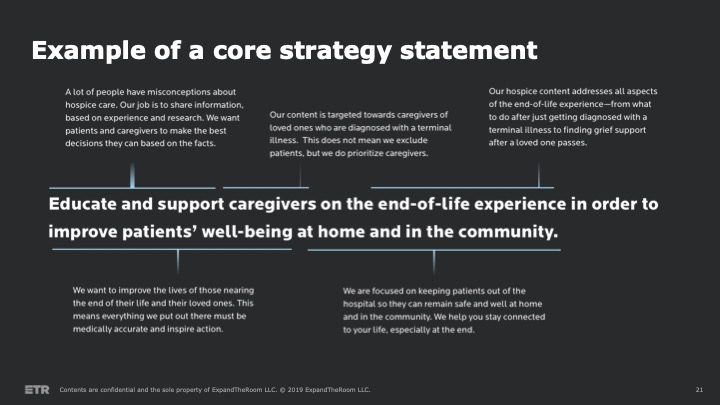
Here’s an example of a core strategy statement. This is a slightly altered version of one we presented recently for a client. This is an annotated sentence format and I found this to be very effective. I got this format from Kristina Halvorson’s Content Strategy For The Web. It’s really nice because it’s so bite-size it’s very easily digestible. When I present this in a real-life scenario to a client, I would stage out each of these annotations one by one so we really talk through the entire statement. Every piece of this has meaning.
Moving on to message architecture. So first defining it. What is a message architecture? It defines the organization’s primary communication goals. These are things that you want your users to remember about you. Message architecture is important because it drives a consistent user experience, both visually and verbally.
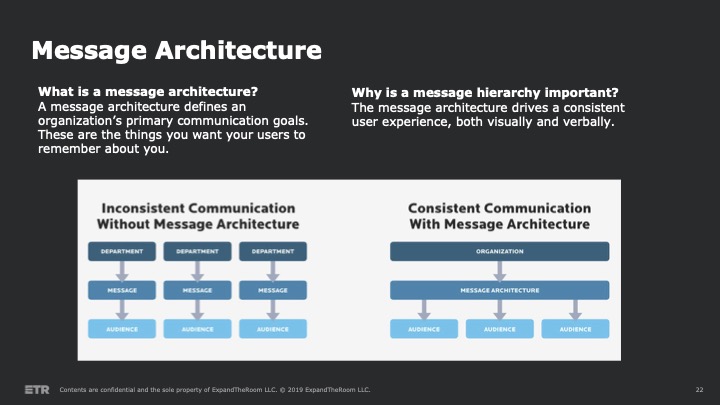
I just love this illustration. I think it’s so clearly demonstrates the importance of having a consistent hierarchy of communication goals. Without having this in place, you’re going to have a bunch of siloed departments putting out each their own individual messages for their individual audiences. You’re going to be able to tell that the organization website’s content does not gel when you jump from one section to the other. It’s going to feel very different to make things more cohesive message architecture really helps to do that. Then you can tailor your messages for each of your audience, but they’re all getting the same core message.
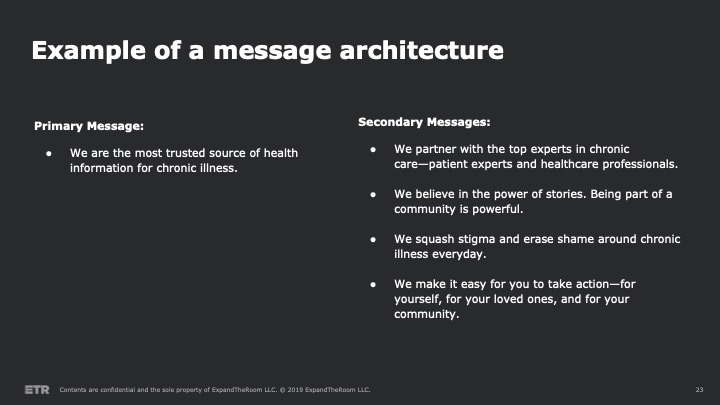
Here’s an example of the message architecture. This is going with the format of you have one primary message and then a series of prioritized secondary messages. This is taking a sentence format to describing the message architecture, because that’s what worked for the specific client in this case. Sometimes it’s enough for the team to work with to just do a series of prioritized adjectives: authoritative, trustworthy, credit. Whatever those key things are. The most important thing is that it resonates with the internal team who’s going to be working with this and using this. You’ll never see this appear in actual content on a website, it’s really to drive internal decision-making and prioritization.
Then finally looking at the people components. So workflow and governance. This is really about defining the process, designating clear ownership and making sure everybody knows the rules so that everyone can play by the rules. This whole piece of content strategy is really an effort to remove subjectivity from the approval process. If everybody’s aligned on who owns what, what the common goals are and how we get there it makes it a lot easier for content to get approved because everyone’s working from the same set of goals.
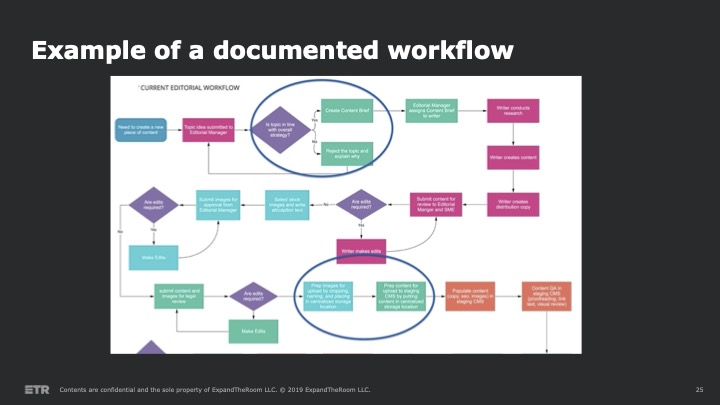
Here’s an example of a documented workflow that we recently did for a client. This is something that Kerrin helped me put together. I had a massive Google doc listing out this whole process and Kerrin transformed it into an amazingly helpful flow chart. Describing and making it visual and visible how involved it is to get a piece of content from idea to actually publish on the site.
Part of the presentation was to document their existing workflow. Then the strategy piece of it was identifying areas that where there were inefficiencies and that we needed to improve. This was tremendously helpful for the client, for the editorial team, just to make it clear how much work goes into it. So many people still have this misconception that writing content involves a few hours, you just write an article. There’s actually a whole lot of work and thought that needs to go into it.
The final step is to make an action plan. So this is how you get from where you are to where you’re going. These are the concrete steps. Then you come up with your strategy where you’re going and here’s the plan on how to get there.
Every content strategy should include an action plan with specific tactics and recommendations. Some things you might include are:
- What user needs the actions client should prioritize.
- What actions the clients should prioritize. I like to think of this on an effort impact matrix and try to target low effort, high impact items.
- Identify what contents remove or discontinue.
- Identify what new on strategy content the client should be creating and what format.
- Suggesting what distribution channels to explore a discontinue based on what you know about the audience needs.
There could be a whole bunch of other things that you include an action plan, depending on the specific needs of the client and where they’re at and what their resourcing is. These are often areas that I hit on as part of any strategic recommendation.
It’s also really important to include specific ways to measure success as part of a content strategy so that you can evaluate whether or not it’s working. I’ve recently started looking into setting and been trying to do this in practice setting smart goals. Those are goals that are SMART.
- Specific
- Measurable
- Achievable
- Relevant
- Time-based
Really getting granular with the goal setting so that it’s easier to measure. Just increasing traffic to the website is too vague. It’s too broad. It’s too hard to measure. It’s more effective to get granular.
An example of a smart goal, which is an alteration of something I’ve used recently, is to publish three new pieces of content a month in order to increase unique page views on a website by 10%, by the end of 2019.
This is very specific.
It’s measurable in two ways: By the number of pieces of content, as well as the amount that you’re trying to increase page views by.
It’s achievable: It’s within the client’s resourcing that it’s achievable.
It’s relevant to the client’s goals, which is to increase traffic to the website.
It’s time-based: By the end of 2019 is when the goal is set.
So how do you package this all up? A typical content strategy package includes these three elements but there’s a lot more that could go into it.
- Content Strategy Deck containing audit findings, core strategy, and specific action items
- Content Audit Data
- Message Architecture with Voice and Tone Guidelines
Any one of these deliverables that you see here could be produced under a content strategy umbrella. It really depends on the project that you’re working on and the goals of the project and what’s going to be most helpful for the client. Content style guides and content templates are something we’ve used a lot more recently … metadata recommendations, personas there’s a lot of different angles to come at it.
A little bit about what kind of clients could benefit from content strategy. These are some signs I think it makes sense to keep an eye out for:
- Clients who don’t know how much or what types of content they have. That’s a big red flag that they could probably use some content strategy assistance.
- Clients who have a really content heavy site. So a sprawling site with thousands of pages or content spread out over multiple sites. Especially if those sites don’t have any documented content strategy, they could likely use some help there, specifically starting with an audit in those cases.
- Clients who have already identified content as an issue, or have gotten burned by content issues on past website projects are great candidates for content strategy.
- Clients who do not have a plan for who’s going to rewrite content as part of a site redesign effort. If there’s not a plan for who’s going to write it, it’s a good sign they probably don’t understand how much work that’s going to involve. Which means they could probably use content strategy.
- Clients who don’t have a person who is responsible for overall content quality. It’s amazing how often you still run into this. Note there’s no person actually in charge of the content which is how it deteriorates over time.
- Clients who want to rank higher in search results. I think that people who are after quick wins and improvement in SEO is often an indicator that there’s a deeper underlying need to evaluate the purpose of their content.
- Clients who aren’t able to articulate their mission or brand values. If clients don’t have a ready answer to what their users need, it’s a really good sign that they’re probably not operating with a good content strategy.
Some other things that are important to know about content strategy
- Content strategy is scalable. It can be broad or narrow. We can have big budgets or little budgets. It really depends on the specific need and we can scale it up and down as needed, depending on budget constraints, resourcing constraints, etc.
- Content strategy is really flexible. We can do content strategy for product design. We can do content strategy for website design. We can really tailor it to fit our needs.
- Content strategy is actionable. It’s not something that’s meant to be delivered and then just sit in a Google drive. Content strategy is meant to be used every day on an ongoing basis. Once it’s been developed to help make decisions going forward and to help make your content, maintain your content.
- Content strategy can be useful at any point in a project. It relates to a lot of the work that we’re already doing. And we’re already considering a lot of these things.
How content strategy relates to:
- SEO: Keyword research helps us uncover user intent and helps us better understand users, which then helps us better deliver that content to them.
- Brand work: Content strategy helps take those brand values that we offer an art direction that we defined at the beginning of the project, and really make it actionable through developing a message architecture.
- UX work: Content strategy thinking helps to better inform wireframes site maps and user.
- Visual design work: Having those prioritized communication goals in the form of a message architecture really does inform visual design choices and hierarchies and what you decided.
- Development work: Content strategy should inform CMS requirements. What are the most important things that the people in and out of the CMS need to know in order to be able to reliably and consistently produce good content.
- Production work: thinking about content strategy and the estimation and project management phase of a project will give us more accurate timelines and budgets, and we can better manage risk if we understand how much complexity is involved in the content.
A few ideas for leveling up on content strategy.
- Figure out how to more effectively include the PEOPLE parts of the content strategy puzzle: workflow and governance. Really going a little more heavy handed on workflow and governance. Historically I focus primarily on the substance and structure pieces of the content puzzle, but finding that this workflow and governance piece is really critical for actually getting content strategy to last and to actually be upheld into work.
- Integrating our brand and content strategy offering more seamlessly. I’m excited to keep that conversation going because I do think these things are so closely related and tying content strategy to brand can help make the branding work that we do more tangible in a way.
- Incorporating messaging testing into our process. This is something that came up in the design meeting recently. A quick test that we could do on a new redesign for messaging is to test the homepage and find out to people, understand what we offer. I think there’s quick wins. We could do to find out if the message is coming through as intended.
- Figuring out way to measure results specifically related to the content strategy so that we can prove its effectiveness and actually evaluate progress over time.
Here are a bunch of my favorite resources. I have so many books on content strategy. What’s not included here is the Content Strategy Podcast, which is another fantastic resource I’ve been using a lot as well as GatherContent and Contently. Both of those companies offer content management software. They produce an incredible amount of helpful content.
- Content Strategy for the Web
- How to Make Sense of Any Mess
- Content Strategy at Work
- Content Design
- Elements of Content Strategy
- Designing Connected Content
- BrandSort Cards
- Information Architecture Lenses
- One Hour Content Plan
Lastly, I just want to end on this quote that I love and I constantly want to remember:
“Most people aren’t coming to a website and go— “wow look this design”, or “wow look at this information architecture”, or “wow look at this UX!” Users come to a site for the content. They come for information.”
Ben Grose, Content Strategist.
If you need an expert team of content strategy to help make your project a success, consider reaching out to ETR to discuss your unique user research needs.
More Insights
SEO Tips for Article Writing
Search engine optimization best practices are really important to keep top of mind so that you can make sure that the great content that you’re writing is actually getting picked up on search engines. Read on for some tips on how to write articles that maximize search visibility.



